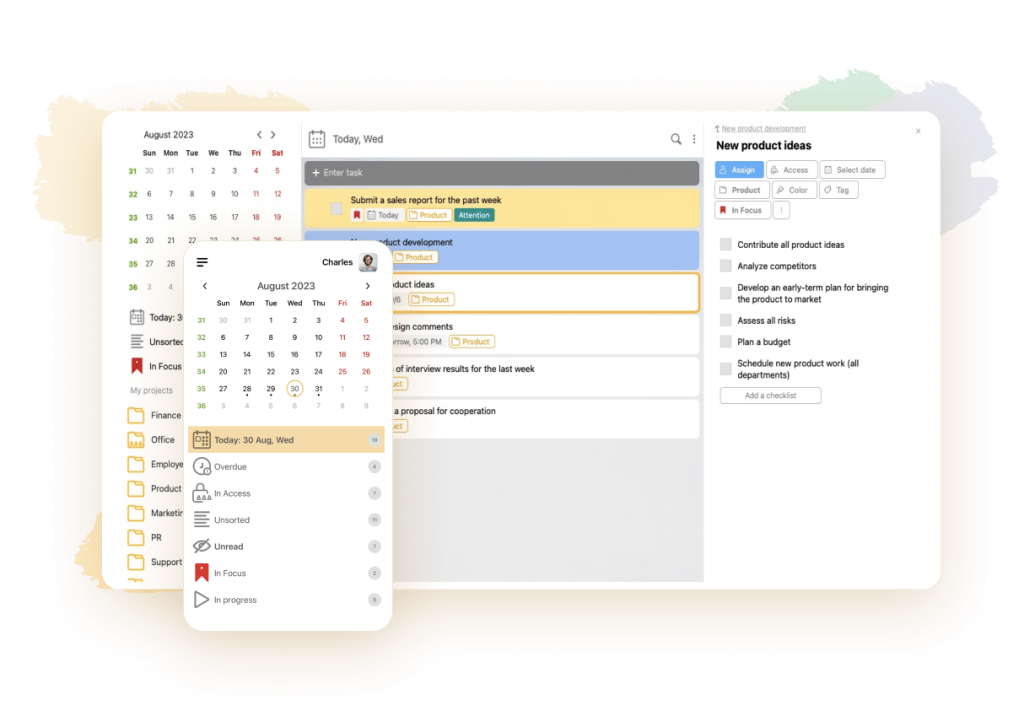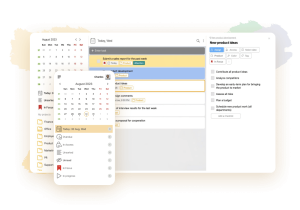Principles of Agile approach in project management

In {year}, project management involves the use of many tools and methods to help improve quality, optimize the finished product. This is due to the fact that it is difficult for large companies to deal with organizing the activities of teams of people, since they involve a large number of participants.
To improve performance in project management, a number of distinct team management skills need to be learned. Agile Project Management is often used for this purpose. We will discuss what Agile is in detail in this article: we will give an overview of the system, tell you what the term means, what the methodology is based on and why it is so popular.
What is Agile
Agile is a set of methods for project management in application areas, initially used only in the IT field. Agile Project Management is used to increase the speed of key product development, reduce development risks, and increase communication between team members around the world. The framework makes it possible to react quickly to the changes made and helps to quickly correct the detected defects, errors, deviations of the customer as a whole.
Agile method is based on the classical cascade model (Waterfall), in which processes are implemented one after another, in the order of priority, i.e. in stages. Therefore, in case the requirements to the final goal change or a noticeable difference from the intended plan was recorded, it is necessary to redo the entire completed part of the work. The solution to this problem is simple and quick due to the flexibility and adaptive properties of the methodology.
Agile Project Management has a number of differences from other approaches that also deal with the creation of a detailed product. The essence of Agile comes down to the fact that there is a theoretical basis – a manifesto, which in turn contains four core values, as well as twelve basic principles. Without these principles it is impossible for the system to exist.
Consider what values the system manifests:
- Communication and human connection is more important than the activities and mechanical tools used in the work.
- The quality of the finished product is prioritized over detailed technical documentation.
- Cooperation and mutual understanding with customers is more important than contractual terms.
- Rapid response to change is more substantially committed to the original plan.
In addition, in Agile Project Management it is customary to distinguish twelve work practices, which were compiled by the first followers and are the basis of the philosophy of the agile method. They included the main points of software development, based on the best principles and rules of testing and program development, but now they are also useful for other areas of business. According to these principles, the main priority in project development is to satisfy the client’s needs by delivering valuable software on a regular basis.
Also key factors of the methodology recognize the importance of changing the product at any stage of project management (if necessary, client request, discovered defects), frequent releases, sprints, the importance of employee motivation, simplicity, continuous attention to design excellence.
Let us consider some fundamentally basic concepts without which this approach cannot exist.

What roles exist in Agile
Three roles in the agile approach are distinguished. These include the following participants:
- product owner – a person who does not have knowledge of the technical details of project development, but has a general vision of the finished result; also realizes what audience the end result is intended for, what tasks the product should perform;
- action coordinator (team leader) – a master responsible for team processes and directing the potential of subordinates in the right direction;
- development team – the main personnel involved in creating the main product and realizing its technical characteristics.
At the same time, the structure in project management of a working group has a horizontal hierarchy. In fact, the manager does not command, but sets the tone, the general direction in which the staff further realizes tasks, comes up with ideas, and solves issues.
An important feature of the hierarchy in Agile Project Management is that it is not based on power, but on competence. It is competence that defines the key parameters of interaction between subordinates and the team coordinator.
What is throughput
Another important characteristic of the framework is throughput. This approach implies a realized number of so-called “user stories”. It includes wishes, customer edits that form future tasks for the team. For example, installing search filters, improving customer feedback on the site, working with tech support. In such a short lean structure, the best iteration can be briefly selected and implemented in a series of steps.
Throughput can also be measured. This is most often measured by the number of user stories processed per week.
How sequencing and prioritization are determined
The order and prioritization of iterative tasks included in the methodology depend on the direction of the firm where Agile Project Management will be applied. Two cycle systems are basic:
- Value Based – assessing the value, the weight of the business; here each task is considered in terms of its profitability, billability, reputation growth and aggregate level of subscriber satisfaction.
- Technology Risk Based – risk assessment from a technological point of view; here the priority depends on the risk of fulfillment of requirements from a large number of set conditions, external interaction.
How a problem-solving schedule is drawn up
Special online services and applications with templates for project planning allow you to make schedules, set tasks and monitor the fulfillment, noting the degree of progress, the stage of product creation and weaknesses in the project. Later we will tell you about one of the suitable services for such activities.
Methods within the Agile methodology are more commonly used: kanban boards and scrum collaboration techniques. Popular tools of agile methodology are successfully used to solve various business processes, but implementation is not always easy and carefree, it may take more than one year. Let’s consider the best way to implement it in practice.
How the Agile method is implemented and applied
So, what is the right way to make the transition from the conventional cascading model used by most organizations to an Agile Project Management system with a set of proprietary Agile methods, techniques and methods? For a painless process, it is recommended to implement the change using several steps:
- to eliminate hierarchy, to achieve equal obligations for each participant in the project, so that everyone bears equal responsibility for the finished result;
- focus on the guaranteed benefits of each stage of development so that all stages and phases of the project bring something new to the table;
- explain the new principles of work to clients and senior management, and help them get into the process.
Implementation of Agile technology should be accompanied by the selection of the main tool in the agile system, setting goals, deadlines, and the size of the team. In addition, each employee must be trained in the application of these methodologies on a mandatory basis. Management and other managers should not hinder the process, realizing that the introduction of this system implies a new turn in business development.
At the stage of rooting the system and transforming the work of the team, it is necessary to additionally involve specialists with certification and experience in Agile Project Management. They will help to form a project team, implement the methodology, select tools, and perform the first analytics.
The procedures don’t always go smoothly, but with proper attention to each stage of implementation in project management, you will notice that processes have become more efficient and the quality of work has greatly increased.
Advantages and disadvantages
Continuous striving of developers and the company executing the project allows to achieve perfect results and remain competitive for a long time. In addition, Agile project system has other advantages over other project methodologies:
- flexible management, which allows to quickly adjust to the consumer of the final product, customer requirements;
- adaptive mechanisms to help you focus easily on what’s important;
- transparency of the process, prompt decision-making, quick start-up, easy response to any changes, seamless detection, error correction;
- simplified communication, no bureaucracy, constant real-time communication between clients and developers;
- frequent, expected releases, shorter timeframes to deliver results;
- minimum number of defects in the final product, maximum level of development quality;
- increasing the functions of the finished product;
- customer focus, high level of customer satisfaction.
However, the Agile methodology also has disadvantages that cannot be overlooked. For example, they include:
- reduction of technical documentation, which affects the process of development of the final product, its operational properties;
- high demand only for motivated, qualified employees;
- the inability to make long-term plans;
- lack of a direct correlation between planning acceleration and the scale of the product being developed, resulting in occasional architectural errors;
- constant feedback from clients, which often requires frequent revisions, leads to deadline postponements, and creates the threat of endlessly ongoing work;
- the need for frequent meetings with customers, distracting from the work process;
- the need for regular customer attendance at the production site;
- possible defects in the finished product due to the need to make quick decisions.
It turns out that before using the methodology in a company, it is necessary to weigh all the pros and cons, as well as to decide whether the Agile approach in the development of the finished product, project, product and service resonates with a particular firm, employees, thinking of managers.
In what cases is it used
Initially, Agile Project Management was constantly used among successful software, game and interface developers. The most active users were considered to be corporations: Google, Microsoft, Netflix, Adobe, WordPress, Spotify, Dell and other families of programmers.
Today, the framework is used in almost all areas of business regardless of its scale, cause, meaning, number of employees, projects taken. For example, it is actively exploited by Saab, General Electric, John Deere. However, the most effective technique is still used in the IT sphere. At the same time, Ajail is most useful for small teams creating and improving a certain product (or service) under conditions of uncertainty, for example, in media business.
The Agile method allows start-up companies to release the first version of a product as quickly as possible to outpace competitors. It also works well when developing innovative products that have no analogues, with highly unpredictable characteristics and properties.
It turns out that the Agile methodology fits best in the life of innovative startups, but in almost no way contributes to the performance and productivity of large corporations with well-established processes and complex structure.
LeaderTask – an application for project management

Online services, special programs help to work more quickly and easily with projects using Agile Project or Scrum methodology. One of the most effective applications of this format is LeaderTask – a special task scheduler with support for Agile Project Management methodology. It is a unique software that easily and with full dedication works with tasks, sets goals for the team, and evaluates the finished result.
Among the necessary tools, LeaderTask includes a task setting function with deadline control, sub-tasking, viewing of achievements, statuses of readiness of tasks in progress. In addition, the application has labels and color selections for tasks, collaborative and individual kanban boards.
Conclusion
In simple words, Agile Project Management is a well-known, flexible and indispensable methodology that allows you to work efficiently and dominate the market. With its help, projects of different scale and format are created in any sphere, business direction. The approach keeps the working team energized, helps to achieve the best results, allows developers and customers to cooperate, and brings satisfaction from the fulfillment of activities to the project participants.
The greatest effect when working with the methodology can be achieved by using specialized guides and online programs that are designed for project management. Such a service is a convenient scheduler LeaderTask, consisting of effective tools. Download the software on our website, use it and achieve the best results! Good luck!



